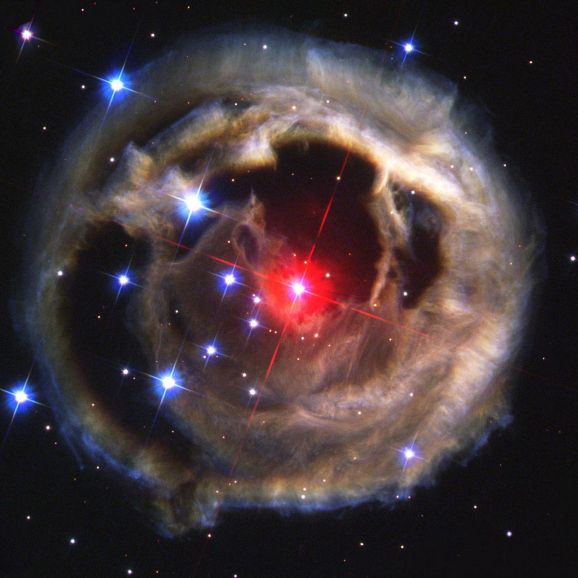Credit & Copyright: H. Bond (STScI),
A. Henden (USNO Flagstaff),
Z. Levay (STScI),
et al.,
ESA,
NASA
Explanation:
Nominated
for most mysterious star in the Milky Way,
V838 Monocerotis briefly became one of the brightest stars
in our galaxy.
Its outburst
discovered
in January 2002,
observations have
indicated that V838
Mon somehow
transformed itself
over a period of months from a small under-luminous star a
little hotter than the Sun, to a highly-luminous,
cool supergiant star -- defying the conventional understanding
of erupting stars and stellar life cycles.
In this
spectacular image, one of a
series recorded last year by the Hubble Space Telescope, the dimmed
V838 Mon is surrounded by an "expanding" nebula.
But the nebula
is actually a series of
light
echoes from formerly unseen shells of dust up to light-years
in diameter.
Previously ejected, the intricate shells
progressively
reflect light as it reaches them from V838 Mon's outbursts.
Astronomers anticipate that light echoes from farther out
in the dust envelope will continue to be visible
until about 2010.
Some estimates now
place V838 Mon
about 20,000 light-years from planet Earth.
1999 2000 2001 2002 2003 2004 2005 2006 2007 2008 2009 2010 2011 2012 2013 2014 2015 2016 2017 2018 2019 2020 2021 2022 2023 2024 2025 |
Yanvar' Fevral' Mart Aprel' Mai Iyun' Iyul' Avgust Sentyabr' Oktyabr' Noyabr' Dekabr' |
NASA Web Site Statements, Warnings, and Disclaimers
NASA Official: Jay Norris. Specific rights apply.
A service of: LHEA at NASA / GSFC
& Michigan Tech. U.
|
Publikacii s klyuchevymi slovami:
v838 mon - variable star - light echo - zvezdy, peremennye - tumannost'
Publikacii so slovami: v838 mon - variable star - light echo - zvezdy, peremennye - tumannost' | |
Sm. takzhe:
Vse publikacii na tu zhe temu >> | |
